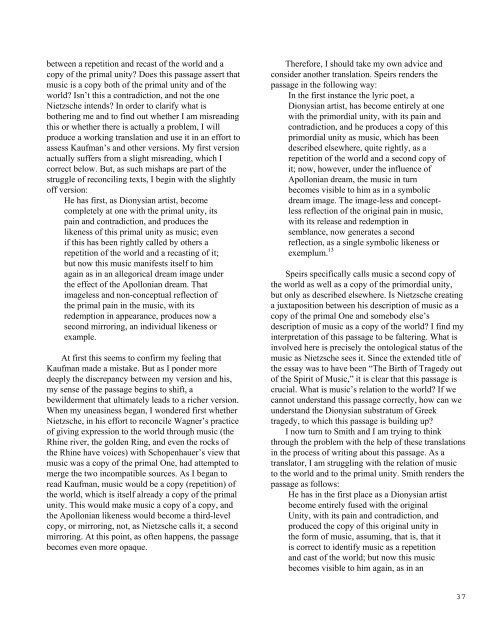their - The University of Texas at Dallas
their - The University of Texas at Dallas
their - The University of Texas at Dallas
Create successful ePaper yourself
Turn your PDF publications into a flip-book with our unique Google optimized e-Paper software.
etween a repetition and recast <strong>of</strong> the world and a<br />
copy <strong>of</strong> the primal unity Does this passage assert th<strong>at</strong><br />
music is a copy both <strong>of</strong> the primal unity and <strong>of</strong> the<br />
world Isn’t this a contradiction, and not the one<br />
Nietzsche intends In order to clarify wh<strong>at</strong> is<br />
bothering me and to find out whether I am misreading<br />
this or whether there is actually a problem, I will<br />
produce a working transl<strong>at</strong>ion and use it in an effort to<br />
assess Kaufman’s and other versions. My first version<br />
actually suffers from a slight misreading, which I<br />
correct below. But, as such mishaps are part <strong>of</strong> the<br />
struggle <strong>of</strong> reconciling texts, I begin with the slightly<br />
<strong>of</strong>f version:<br />
He has first, as Dionysian artist, become<br />
completely <strong>at</strong> one with the primal unity, its<br />
pain and contradiction, and produces the<br />
likeness <strong>of</strong> this primal unity as music; even<br />
if this has been rightly called by others a<br />
repetition <strong>of</strong> the world and a recasting <strong>of</strong> it;<br />
but now this music manifests itself to him<br />
again as in an allegorical dream image under<br />
the effect <strong>of</strong> the Apollonian dream. Th<strong>at</strong><br />
imageless and non-conceptual reflection <strong>of</strong><br />
the primal pain in the music, with its<br />
redemption in appearance, produces now a<br />
second mirroring, an individual likeness or<br />
example.<br />
At first this seems to confirm my feeling th<strong>at</strong><br />
Kaufman made a mistake. But as I ponder more<br />
deeply the discrepancy between my version and his,<br />
my sense <strong>of</strong> the passage begins to shift, a<br />
bewilderment th<strong>at</strong> ultim<strong>at</strong>ely leads to a richer version.<br />
When my uneasiness began, I wondered first whether<br />
Nietzsche, in his effort to reconcile Wagner’s practice<br />
<strong>of</strong> giving expression to the world through music (the<br />
Rhine river, the golden Ring, and even the rocks <strong>of</strong><br />
the Rhine have voices) with Schopenhauer’s view th<strong>at</strong><br />
music was a copy <strong>of</strong> the primal One, had <strong>at</strong>tempted to<br />
merge the two incomp<strong>at</strong>ible sources. As I began to<br />
read Kaufman, music would be a copy (repetition) <strong>of</strong><br />
the world, which is itself already a copy <strong>of</strong> the primal<br />
unity. This would make music a copy <strong>of</strong> a copy, and<br />
the Apollonian likeness would become a third-level<br />
copy, or mirroring, not, as Nietzsche calls it, a second<br />
mirroring. At this point, as <strong>of</strong>ten happens, the passage<br />
becomes even more opaque.<br />
<strong>The</strong>refore, I should take my own advice and<br />
consider another transl<strong>at</strong>ion. Speirs renders the<br />
passage in the following way:<br />
In the first instance the lyric poet, a<br />
Dionysian artist, has become entirely <strong>at</strong> one<br />
with the primordial unity, with its pain and<br />
contradiction, and he produces a copy <strong>of</strong> this<br />
primordial unity as music, which has been<br />
described elsewhere, quite rightly, as a<br />
repetition <strong>of</strong> the world and a second copy <strong>of</strong><br />
it; now, however, under the influence <strong>of</strong><br />
Apollonian dream, the music in turn<br />
becomes visible to him as in a symbolic<br />
dream image. <strong>The</strong> image-less and conceptless<br />
reflection <strong>of</strong> the original pain in music,<br />
with its release and redemption in<br />
semblance, now gener<strong>at</strong>es a second<br />
reflection, as a single symbolic likeness or<br />
exemplum. 13<br />
Speirs specifically calls music a second copy <strong>of</strong><br />
the world as well as a copy <strong>of</strong> the primordial unity,<br />
but only as described elsewhere. Is Nietzsche cre<strong>at</strong>ing<br />
a juxtaposition between his description <strong>of</strong> music as a<br />
copy <strong>of</strong> the primal One and somebody else’s<br />
description <strong>of</strong> music as a copy <strong>of</strong> the world I find my<br />
interpret<strong>at</strong>ion <strong>of</strong> this passage to be faltering. Wh<strong>at</strong> is<br />
involved here is precisely the ontological st<strong>at</strong>us <strong>of</strong> the<br />
music as Nietzsche sees it. Since the extended title <strong>of</strong><br />
the essay was to have been “<strong>The</strong> Birth <strong>of</strong> Tragedy out<br />
<strong>of</strong> the Spirit <strong>of</strong> Music,” it is clear th<strong>at</strong> this passage is<br />
crucial. Wh<strong>at</strong> is music’s rel<strong>at</strong>ion to the world If we<br />
cannot understand this passage correctly, how can we<br />
understand the Dionysian substr<strong>at</strong>um <strong>of</strong> Greek<br />
tragedy, to which this passage is building up<br />
I now turn to Smith and I am trying to think<br />
through the problem with the help <strong>of</strong> these transl<strong>at</strong>ions<br />
in the process <strong>of</strong> writing about this passage. As a<br />
transl<strong>at</strong>or, I am struggling with the rel<strong>at</strong>ion <strong>of</strong> music<br />
to the world and to the primal unity. Smith renders the<br />
passage as follows:<br />
He has in the first place as a Dionysian artist<br />
become entirely fused with the original<br />
Unity, with its pain and contradiction, and<br />
produced the copy <strong>of</strong> this original unity in<br />
the form <strong>of</strong> music, assuming, th<strong>at</strong> is, th<strong>at</strong> it<br />
is correct to identify music as a repetition<br />
and cast <strong>of</strong> the world; but now this music<br />
becomes visible to him again, as in an<br />
37

















